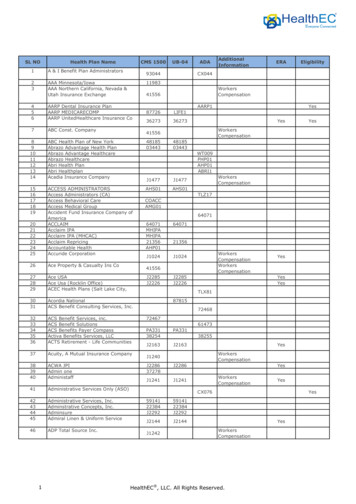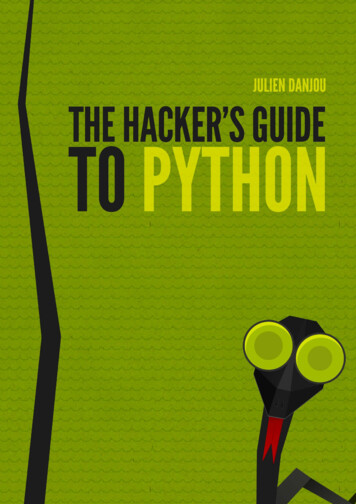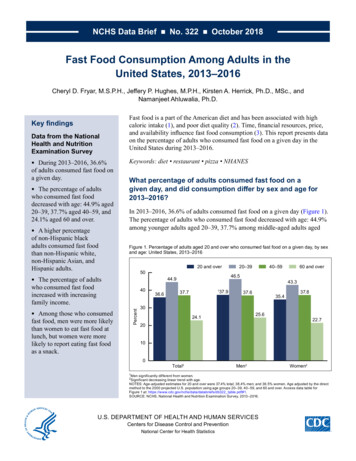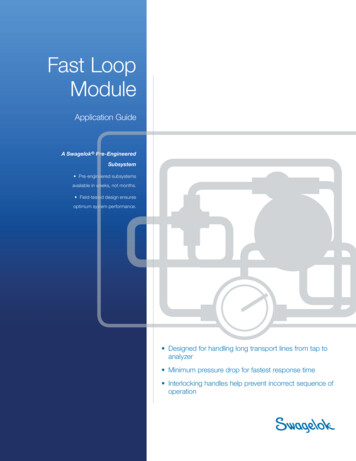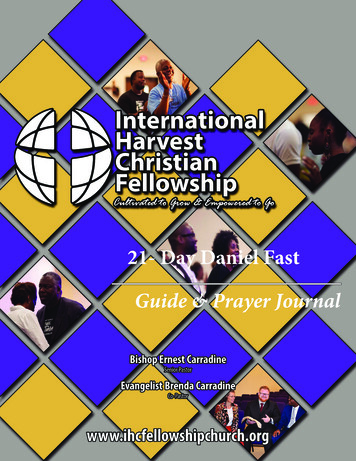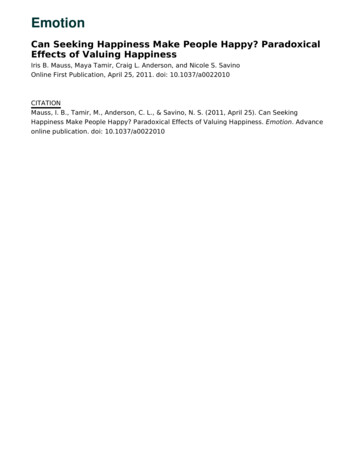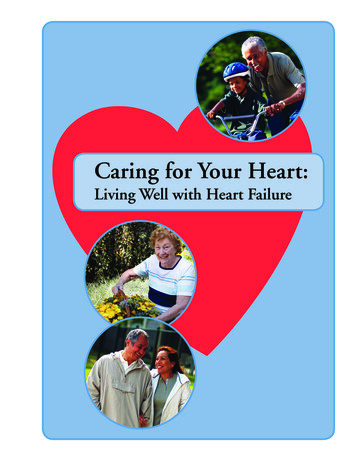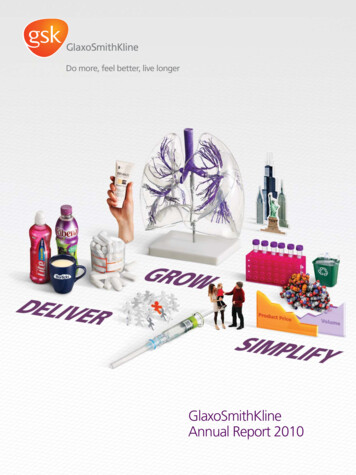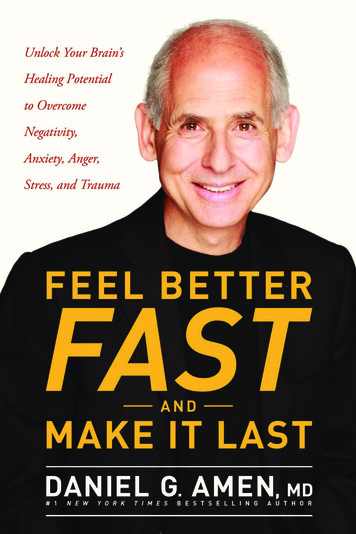
Transcription
Feel Better Fast and Make It Last gives you the latest fascinatingand important neuroscience information on how to boost yourmood, quiet anxiety, and increase your overall brain health. I highlyrecommend it.ANDREW NEWBERG, MDThomas Jefferson University; coauthor of How God Changes Your BrainLife is full of challenges for everyone. But contrary to what you maybelieve, these events need not preclude your ability to be happy andjoyful. In Feel Better Fast and Make It Last, Dr. Daniel Amen gives usa powerful array of tools to redirect our brains away from despair andgrief to a place of happiness, gratitude, and love. This book is truly aprecious gift.DAVID PERLMUTTER, MDAuthor of #1 New York Times bestseller Grain Brain and The Grain Brain WholeLife PlanThis book is delightful to read, a guide full of useful information for all ofus that will help our brains and help our lives and our habits. All of us whohave read it have been helped by it.ANDREW CAMPBELL, MDEditor in chief, Advances in Mind-Body MedicineFeel Better Fast and Make It Last is the one book about the brain thatyou’ll want to read this year. I have been working with Dr. Amen for thepast 25 years, and this book is his most exciting work yet. Do you wantto discover the secrets of quantum change? If you want to transform yourlife, take the practical steps outlined in this book, which will help youfeel better fast and make it last. This book will give you what you needto bring lasting change to your brain. Feel Better Fast and Make It Last isyour manual for transformed life!DR. EARL HENSLINClinical psychologist and author of This Is Your Brain on Joy
Daniel has taught me (and countless others) the critical role our brainhealth plays in our careers, families, and overall quality of life. If youtruly value the relationships in your life, stop what you’re doing andread this book.TODD DAVISFranklinCovey’s chief people officer; Wall Street Journal bestselling author ofGet Better: 15 Proven Practices to Build Effective Relationships at WorkThis book is your map to an abundant life! Imagine sitting down withone of the smartest, most passionate doctors on the planet and getting apersonalized plan for the healthiest version of you. That is the experienceof reading Feel Better Fast and Make It Last.To know Dr. Amen is to believe that your life can be all it was meantto be. This book feels like sitting with him in his office and getting hispersonal plan for your healthiest life.Healthy people build healthy families. Healthy families create ahealthy world. If you want to positively change your life and the livesof generations that will follow you, you must read this book!JEN ELMQUIST, MA, LMFTMental and relational health expert and author of Relationship ResetOur choices determine our results, and our results determine our success. Itall begins with choices. But the question is, which choices are right? Howcan we choose to live with joy, creativity, and prosperity, and free ourselvesfrom depression and panic? With his astonishing new research, DanielAmen has unlocked the answers. In this book, you’ll discover new aspectsof who you are and who you can become. Once you understand yourown emotions and behaviors, you can replace the negative with a positivefuture. This book outlines the game plan to your most fascinating andfulfilling life.SALLY HOGSHEADNew York Times bestselling author and creator of the Fascination Advantage personality test
Dr. Daniel Amen keeps writing cutting-edge, easy-to-understand books onwhat is most important to a healthy and happy brain. This is his best bookyet. Dr. Amen shows us how we can all have good brains, overcome life’smain stressors, and foster healthy lives. Feel Better Fast and Make It Lasthas motivated me to change my lifestyle, keeping the health of my brain inmind. This book will be on my “must read” list for all my clients—and myfamily members.Dr. Amen’s Feel Better Fast and Make It Last is a get-you-thinking andstart-changing book that doesn’t make you feel guilty but educates you intowanting to live with your brain as your first priority.I could not put down Feel Better Fast and Make It Last, as it wasreadable, easy to understand, and related to my life. It shook me up andgave me new habits of asking myself each day, “Is this good or bad for mybrain?” and making daily decisions based on “Will this make me feel goodnow but not later?” Dr. Amen’s contribution to brain health is helping usall improve our lives.SHARON MAY, PhDFounder of Safe Haven Relationship Center and author of Safe Haven MarriageWe’ve all found ourselves reacting to one event or another—landing in aplace we never expected to be. These ground-shaking moments can leave usfeeling anxious, sad, angry, scared out of our minds, or worried. We wanthelp, and more importantly, we need it now. We don’t have to remain stuckin our pain. Dr. Amen’s simple, hands-on, and very doable steps can changewhat seems unchangeable. Why wait, struggle, or hope for tomorrow whenyou can feel better fast today?SHERI KEFFER, PhDAuthor of Intimate Deception: Healing the Wounds of Sexual Betrayal
A SAMPLE OF OTHER BOOKS BY DANIEL AMENMemory Rescue, Tyndale, 2017Stones of Remembrance, Tyndale, 2017Captain Snout and the Super Power Questions, Zonderkidz, 2017The Brain Warrior’s Way, with Tana Amen, New American Library, 2016The Brain Warrior’s Way Cookbook, with Tana Amen, New American Library, 2016Time for Bed, Sleepyhead, Zonderkidz, 2016Change Your Brain, Change Your Life (revised), Harmony Books, 2015, New YorkTimes BestsellerHealing ADD (revised), Berkley, 2013, New York Times BestsellerThe Daniel Plan, with Rick Warren, DMin, and Mark Hyman, MD, Zondervan,2013, #1 New York Times BestsellerUnleash the Power of the Female Brain, Harmony Books, 2013Use Your Brain to Change Your Age, Crown Archetype, 2012, New York TimesBestsellerThe Amen Solution, Crown Archetype, 2011, New York Times BestsellerUnchain Your Brain, with David E. Smith, MD, MindWorks, 2010Change Your Brain, Change Your Body, Harmony Books, 2010, New York TimesBestsellerMagnificent Mind at Any Age, Harmony Books, 2008, New York Times BestsellerThe Brain in Love, Three Rivers Press, 2007Making a Good Brain Great, Harmony Books, 2005, Amazon Book of the YearHow to Get Out of Your Own Way, MindWorks, 2005ADD in Intimate Relationships, MindWorks, 2005Preventing Alzheimer’s, with William R. Shankle, MS, MD, Penguin, 2004Healing Anxiety and Depression, with Lisa Routh, MD, Putnam, 2003Healing the Hardware of the Soul, Free Press, 2002New Skills for Frazzled Parents, MindWorks, 2000The Most Important Thing in Life I Learned from a Penguin!?, MindWorks, 1995
Unlock Your Brain’s Healing Potential to OvercomeNegativity, Anxiety, Anger, Stress, and TraumaFEEL BETTERFASTANDMAKE IT LASTDANIEL G. AMEN, MD# 1N E WY O R KT I M E SB E S T S E L L I N GThe nonfiction imprint ofTyndale House Publishers, Inc.A U T H O R
Visit Tyndale online at www.tyndale.com.Visit Tyndale Momentum online at www.tyndalemomentum.com.Visit Daniel G. Amen, MD, at http://danielamenmd.com.TYNDALE, Tyndale Momentum, and Tyndale’s quill logo are registered trademarks of Tyndale HousePublishers, Inc. The Tyndale Momentum logo is a trademark of Tyndale House Publishers, Inc. TyndaleMomentum is the nonfiction imprint of Tyndale House Publishers, Inc., Carol Stream, Illinois.Feel Better Fast and Make It Last: Unlock Your Brain’s Healing Potential to Overcome Negativity, Anxiety,Anger, Stress, and TraumaCopyright 2018 by Daniel G. Amen, MD. All rights reserved.Author photograph by Lesley Bohm, copyright 2013. All rights reserved.Interior photographs, including brain scans, and illustrations provided by author and used withpermission. All rights reserved.Designed by Dean H. RenningerPublished in association with the literary agency of WordServe Literary Group, www.wordserveliterary.com.All Scripture quotations, unless otherwise indicated, are taken from the Holy Bible, New InternationalVersion, NIV. Copyright 1973, 1978, 1984, 2011 by Biblica, Inc. Used by permission. All rightsreserved worldwide.Scripture quotations marked NLT are taken from the Holy Bible, New Living Translation, copyright 1996, 2004, 2015 by Tyndale House Foundation. Used by permission of Tyndale House Publishers, Inc.,Carol Stream, Illinois 60188. All rights reserved.For information about special discounts for bulk purchases, please contact Tyndale House Publishers atcsresponse@tyndale.com, or call 1-800-323-9400.Library of Congress Cataloging-in-Publication DataNames: Amen, Daniel G., author.Title: Feel better fast and make it last : unlock your brain's healing potential to overcome negativity,anxiety, anger, stress, and trauma / Daniel G. Amen, MD #1 New York Times bestselling author.Description: Carol Stream, Illinois : Tyndale House Publishers, Inc., [2018] Includes bibliographicalreferences.Identifiers: LCCN 2018029690 ISBN 9781496425652 (hc)Subjects: LCSH: Self-care, Health. Brain.Classification: LCC RA776.95 .A464 2018 DDC 612.8/2--dc23 LC record available at https://lccn .loc.gov/2018029690ISBN 978-1-4964-3881-2 (International Trade Paper Edition)Printed in the United States of America247236225214203192181
MEDICAL DISCLAIMERThe information presented in this book is the result of years of practice experience andclinical research by the author. The information in this book, by necessity, is of a general nature and not a substitute for an evaluation or treatment by a competent medicalspecialist. If you believe you are in need of medical intervention, please see a medicalpractitioner as soon as possible. The stories in this book are true. The names andcircumstances of the stories have been changed to protect the anonymity of patients.
ContentsIntroduction: You Can Feel Better Fast and Make It Last:The BRAIN- XL Approach xiiiPART 1: B IS FOR BRAIN1. Use Your Brain to Rescue Your Mind and Body: Quick TechniquesWhen Life Feels Out of Control 32. The Missing Strategy: Boosting Brain Health Can Make You FeelGreat Now and for a Lifetime 273. Control Yourself: Boost the Brain’s Executive Center to Make GreatDecisions and Avoid Ones That Ruin Your Life 474. Change Is Easy—If You Know How to Do It: Turn Your Ruts intoSuperhighways of Success 69PART 2: R IS FOR RATIONAL MIND5. Master Your Rational Mind: How to Feel Happy and Present, WhileConquering Worry and Negativity 93PART 3: A IS FOR ATTACHMENTS6. Healing Connections: How to Improve Any Relationship 1217. Overcoming Trauma and Grief: Eliminate the Hurts ThatHaunt You 147PART 4: I IS FOR INSPIRATION8. Create Immediate and Lasting Joy: Protect Your Brain’s PleasureCenters to Live with Passion and Purpose and Avoid Addictions andDepression 177
PART 5: N IS FOR NOURISHMENT9. The Feel Better Fast Diet: Foods That Help You Feel Great Nowand Later 20310. Advanced and B rain- Type Nutraceuticals: A Personalized, TargetedApproach to Getting the Nutrients You Need 229PART 6: X IS FOR THE X FACTOR11. Think Different: 10 Practical Lessons from 150,000 Brain Scans 249PART 7: L IS FOR LOVE12: Love Is Your Secret Weapon: Doing the Right Thing Is the UltimateAct of Love for Self and Others 277Appendix A: Answers to Common Questions on FindingMore Help 289Appendix B: Where Do You Need Help to Feel Better Fast?A Quick Mental Health Checkup 301Appendix C: Know Your Important Health Numbers 309About Daniel G. Amen, MD 315Gratitude and Appreciation 317Resources 319Notes 323
IntroductionYOU CAN FEEL BETTER FAST AND MAKE IT LAST:THE BRAIN- XL APPROACHIt is during our darkest moments that we must focus to see the light.ATTRIBUTED TO ARISTOTLEVirtually all of us have felt anxious, depressed, traumatized, g rief- stricken, orhopeless at some point in life. It’s perfectly normal to go through hard timesor experience periods when we feel panicked or out of sorts, whether we havea diagnosable condition or not. How we respond to these challenges makesall the difference in how we feel— not just immediately, but in the long run.All of us want to stop the pain quickly. Unfortunately, many people s elf- medicate with energy drinks, overeating, alcohol, drugs, risky sexual behavior,angry outbursts, or wasting time on mindless TV, video games, social media,or shopping. Although these substances and behaviors may give us temporary relief from feeling bad, they usually only prolong and exacerbate the problems— or cause other more serious ones, such as energy crashes, obesity,addictions, sexually transmitted diseases, unhappiness, relationship problems,or financial ruin.I am a psychiatrist, a brain- imaging researcher, and the founder of AmenClinics, which has one of the highest published success rates in treatingpeople with complex and treatment- resistant mental health issues such asattention deficit hyperactivity disorder (ADHD), anxiety and mood disorders, posttraumatic stress disorder, and more. Thanks to all of this experience,I understand how critical it is for you to know what will help you feel betterright now and later. In this book I’ll be highlighting strategies that will leadyou to experience more joy, peace, energy, and resilience, both immediatelyand in the future.Plenty of things may help in the short term but will make you feelxiii
xivFEEL BETTER FAST AND MAKE IT LAST orse— or cause more problems— in the long term. Here are two stories thatwillustrate how the right remedies can set you on a healthier, happier course.CHRIS: HELP FOR A GRIEVING MOMI met Chris at my Northern California clinic when I was there giving a lecture. She told me that two years earlier she had lost her 12- year- old daughter,Sammie, to bone cancer. Chris had no idea how hard Sammie’s death wouldhit her. Every night she went to bed with Sammie’s illness and death playingover and over in her mind. Chris ate more and drank alcohol as a way tocope and quiet her mind, but most mornings she woke up in a panic, and theterror would follow her through her days. She felt so useless and depressedthat she had secretly planned on killing herself on the two- year anniversaryof Sammie’s death.Just a few weeks before the anniversary, Chris was visiting with a friendof her sister’s, whom she described as very fit, with a positive attitude. Chris,who is just five feet one inch tall, weighed a little more than 200 pounds andwas walking in a gloom so heavy she thought she’d never smile— and mean it— again. “This friend had a copy of the Change Your Brain, Change YourBody Daily Journal,” Chris explained. “Flipping through it, I thought, Okay,I like this. It makes sense to me. I have to start looking for the brighter side oflife. After all, my choices at that point were to take my life, drink myself todeath, or end up in rehab. And I was way too proud to go to rehab.” Chriswent home and downloaded my book Change Your Brain, Change Your Bodyand read it cover to cover in one night. “I can still remember how I felt in themoment when I read . . . that alcohol stops you from feeling ‘empathy andcompassion for others.’ I knew I needed to get my feelings of empathy andcompassion back for my other children and husband. I needed to find a wayto be happy and whole again for their sakes and my own.“I went hard- core into the plan,” Chris said. “In fact, I did a 28- daycleanse. I tossed out all the alcohol, ate no processed food, and began takingfish oil and vitamin D.” Chris felt better nearly immediately. “Within eightdays I didn’t care if I never dropped a pound again. I was free! Because I waseating food that actually nourished my cells, the food and alcohol cravingsstopped. I got rid of all the diet drinks and colas. I slept through the nightfor the first time in four years, and I didn’t wake up in a panic.” After 10weeks she had lost 24 pounds and was running four days a week. After fivemonths she was down 35 pounds and had lost eight inches off her waist.
IntroductionxvHer skin was brighter, and she felt like a completely new woman. Of courseshe will never forget her daughter, but there is no way that Sammie wouldhave wanted her mother to be in such pain. Now Chris believes that Sammiewould be proud of her.The best time to start healing from a crisis is before it starts. Givingyourself the excuse to eat bad food, drink alcohol, or smoke pot to deal withthe pain only prolongs it. Never let a crisis be your excuse to hurt yourself.If you’re like me, when you hurt, you want to feel better now, fast, pronto!During my psychiatric training I had a wonderful supervisor, Dr. JackMcDermott, who was a world leader in psychiatry. I loved his mentorshipon how to help children, teens, adults, and families who were hurting. In hisprofessional evaluation of me at the end of the year, he wrote, “Dr. Amen isa bright, competent, and caring physician, who will make a wonderful psychiatrist; but he needs to be more patient. He wants people to get better fast.”Then and now, I don’t see wanting people to get better quickly as a problem.That is what people who are in pain want. No one wants to be patient. Noone wants a prolonged process. They want to feel better fast, and they wantthat feeling to last.LEIZA: REVERSING DEPRESSIONAND MEMORY PROBLEMSLeiza, an attractive woman with flaming red hair, was 50 years old when shefirst came to our Atlanta clinic. She had seen one of my public televisionprograms and brought her teenage son to us for ADHD because he had notresponded to treatment. She also decided to be scanned because, as she said,“I’m very scattered, always late, and my memory is poor. . . . My father and hismother had dementia, and I don’t want it. . . . I really feel like I am in the earlystages of dementia. . . . I am tired of being depressed and beating myself up.”She had been an actor and then a stay- at- home mother for 20 years. As herchildren were becoming more independent, she wanted to act again, but shedidn’t believe she could. She told one of her friends, “I could never go backto work. I can’t remember anything. I can’t focus. I can’t make any decisions.”The two years before Leiza came to see us were the most challenging inher life. She had felt a lot of anxiety while taking care of her son’s learning disabilities, her daughter’s depression, and her father’s dementia, and in dealingwith the death of her mother- in- law. With the chronic stress, Leiza noticedmore problems with her memory. She would make appointments and then
xviFEEL BETTER FAST AND MAKE IT LASTforget to show up, despite having put the appointment on her calendar. Sixmonths before her appointment with us, she was diagnosed with ADHD andput on Adderall, but she didn’t think it helped her.As part of our workup of Leiza, we did a brain imaging study calledSPECT (single photon emission computed tomography), which looks atblood flow and activity— essentially, how the brain works. Her SPECT scanshowed severe decreased blood flow across her whole brain, which was veryconcerning given the family history of Alzheimer’s disease. Our research,and that of others, has shown that Alzheimer’s disease and other forms ofdementia start in the brain decades before people have any symptoms. Leizawas already symptomatic, and her brain showed that she was headed for thesame fate as her father and grandmother.Leiza’s scan was the w ake- up call she needed to get serious about rehabilitating her brain now if she wanted to feel better fast and avoid eventually being a burden to her children. She was motivated to do everythingwe recommended, including taking supplements and doing a treatmentcalled hyperbaric oxygen therapy (HBOT; see appendix A, page 292), whichboosts blood flow to the brain. Within several months she noticed significantimprovement in her mood, focus, and memory. She started to audition fortelevision and landed a lead role in a TV pilot as the FBI director. She told menone of it would have been possible without rehabilitating and caring for herbrain. Her f ollow- up scan two years later showed remarkable improvement,which is something we have seen repeatedly over the past three decades. Yourbrain can be better and you can feel better— and we can prove it!How to Read SPECT ScansThroughout this book you’ll see a number of SPECT scans fromAmen Clinics patients.We will include four images; they show the brain first fromunderneath and then, moving clockwise, from the right side, thetop, and the left side. For detailed information about how theSPECT scan works and who should get one, see “When ShouldYou Think about Getting a Functional Imaging Study, Such asSPECT?” on page 271.
IntroductionHEALTHY SPECT SCANLEIZA’S SPECT SCANFull, even, symmetrical activityHoles indicate areas of severedecreased blood flow.xviiLEIZA’S AFTER TREATMENT SPECT SCANMarked overall improvementTHE MISSING STRATEGY TO FEELING BETTER FASTOne of the most important secrets to our success at Amen Clinics is that wefocus first on understanding, healing, and optimizing the physical functioning of the brain (hardware), and second on properly programming it (software). Both always work together, and if you ignore one while only workingon the other, you will have a harder time consistently feeling better.Unfortunately, the vast majority of professionals who are trained to help
xviiiFEEL BETTER FAST AND MAKE IT LASTpeople who are struggling with how they feel receive little to no training onhow to heal and optimize the brain, which limits their success. I recentlylectured to 5,000 mental health professionals and asked them how manyhad received any training on how to optimize the physical functioning ofthe brain during their education; fewer than one percent raised their hands.Physicians have been trying to drug the brain into submission since the1950s. The outcomes have been poor because doctors too often ignore thenecessity of first putting the brain into a healing environment by addressingissues such as sleep, toxins, diet, exercise, and supplementation. Dr. ThomasInsel, former director of the National Institute of Mental Health, wrote,“The unfortunate reality is that current medications help too few peopleto get better and very few people to get well.”1 In contrast with anti biotics,which can cure infections, none of the medications for the mind cure anything. They only provide a temporary bandage that comes off when thepsycho tropic medications are stopped, causing symptoms to recur. In addition, many of these medications are insidious; once you start on them, theychange your brain chemistry so you need them in order to feel normal. Thereis a better way. Feel Better Fast and Make It Last is the manual that helps youunlock your brain’s healing potential to quickly overcome negativity, anxiety,anger, stress, grief, and trauma.Honestly, I, too, undervalued brain health for nearly a decade as a youngpsychiatrist until our group at Amen Clinics found a practical way to lookat the brain. Before we started our brain imaging work in 1991, I had beentrained and b oard- certified as a c hild- and- adolescent psychiatrist and general psychiatrist and was busy seeing children, teens, adults, and older adultswith a wide variety of issues connected with mental health, including depression, bipolar disorder, autism, violence, marital conflict, school failure, andADHD. During that time, I was flying blind and not thinking much aboutthe actual physical functioning of my patients’ brains. Researchers at academic centers told us that brain imaging tools were not ready for clinical practice— maybe someday in the future.I loved being a psychiatrist, but I knew we were missing important puzzlepieces. Psychiatry was, and unfortunately remains, a soft, ambiguous science,with many competing theories about what causes the troubles our patientsexperience. In medical school and during my psychiatric residency and childand-adolescent psychiatry fellowship, I was taught that while we really didn’tknow what caused psychiatric illnesses, they were likely the result of a combination of factors, including
Introduction xix enetics— but no one knew exactly which genes were the realGtroublemakers;Abnormal brain chemistry— which gave us many medications to try,but they only worked some of the time;Toxic parenting or painful childhood experiences— but some peoplethrived even though they were raised in abusive environments, whileothers withered;Negative thinking patterns— but correcting the erroneous thoughtpatterns helped some people and not others.The lack of neuroimaging led to a “brainless” psychiatry, which keptmy profession steeped in outdated theories and perpetuated stigma for ourpatients. I often wondered why all other medical specialists looked at theorgans they t reated— cardiologists, for example, scanned the heart, gastro enterologists scoped the gut, and orthopedists imaged bones and j oints— while psychiatrists were expected to guess at what was wrong by talking topatients. And we were dealing with the most complicated organ of all—thehuman brain! Our patients are every bit as sick as those with heart disease,osteoporosis, or cancer. Depression, bipolar disorder, addictions, and schizophrenia are all potentially lethal disorders, and even issues such as chronicstress, anxiety, and ADHD can affect all aspects of our lives.IMAGING CHANGED EVERYTHINGIn 1991, everything changed for me. My lack of respect for the brain vanishedalmost instantly when I started looking at the brains of my patients with anuclear medicine study called SPECT, mentioned in Leiza’s story on page xvi.It is different from CT or MRI scans, which look at the brain’s anatomy orstructure. SPECT looks at brain function, which is helpful because functionalproblems almost always precede structural problems. SPECT is a leadingindicator of trouble, pointing to issues years before they manifest, while CTand MRI are lagging indicators of trouble that reveal abnormalities later inillnesses. SPECT basically answers a key question about each area of thebrain: Is it healthy, underactive, or overactive? Based on what we see, we canstimulate the underactive areas or calm the overactive ones with supplements,medicines, electrical therapies, or other treatments, all of which optimize thebrain. We can also help patients ensure that the healthy areas of their brainsstay healthy.Almost immediately after starting to look at scans, I became excited about
xxFEEL BETTER FAST AND MAKE IT LASTthe possibilities of SPECT to help my patients, my family, and myself. Thescans helped me be a better doctor, as I could observe the brain function ofmy patients. I could see if their brains were healthy, which meant the issuesthey were facing were more likely to be psychological, social, or spiritualrather than biological in nature. I could see if there was physical trauma fromconcussions or head injuries, causing trouble to specific areas of the brain, orif there was evidence of toxic exposure from drug or alcohol abuse (addictsrarely admit to how much they are using, but it is hard to stay in denial whenlooking at a damaged brain) or other toxins, such as mercury, lead, or mold.I also could see if my patients’ brains worked too hard, which is associatedwith anxiety disorders and o bsessive- compulsive tendencies.I was so excited about imaging that I scanned many people in my ownfamily, including my 60- year- old mother, who had one of the healthiestSPECT scans I had seen. Her scan reflected her life. As a mother of sevenchildren and grandmother and g reat- grandmother of 44, she has always beeneveryone’s best friend. At the time of this writing, she has been married tomy father for 68 years, and she is consistently loving, attached, focused, andsuccessful in every way, including being the club golf champion and a topgolfer for more than 50 years. After scanning my mom, I scanned myself, andmy results were not so good. I had played football in high school and gottensick with meningitis as a young soldier, plus I had a lot of bad brain habits,such as not sleeping more than four hours a night, struggling with beingoverweight, eating junk food, and being chronically stressed at home and atwork. Seeing my mom’s scan and then my own, I fell in love with my brainand vowed to make it better. I also developed what I call brain envy. I comefrom a very competitive family and was highly irritated that my 60- year- oldmother had a better- looking brain than I did at 37. Much of my life after thatmoment has been about making my brain better and teaching others what Ilearned about how to do it. When my brain was rescanned 20 years later, itwas much healthier.Now, close to 30 years after we started to look at the brain at AmenClinics, we have built the world’s largest database of nearly 150,000 brainSPECT scans on patients from 120 countries. Our work has clearly taught usthat unhealthy brain function is associated with a higher incidence of SadnessAnxietyFearPanicBrain fog Poor focusAddictionsDomestic violenceIncarcerationLoneliness
Introduction Suicidal behaviorsViolenceSchool failure xxiDivorceDementiaBy contrast, healthy brain function is correlated with improved HappinessJoyEnergyResilienceFocusLongevity RelationshipsSchool performanceBusiness successWealth managementCreativityThis is what feeling better looks like. As your brain becomes healthier, youwill experience fewer of the problems on the first list and more of the rewardson the second. And as these positive personal characteristics take hold, you’llexperience constructive changes in your attitude, your ability to respond tochallenges, and your sense of purpose.THE BRAIN- XL APPROACHUsing the mnemonic, or memory aid, BRAIN- XL as our framework, I’llintroduce you to the latest research, as well as our clinical experience, tohelp you feel better fast and make it last. First, I want to acquaint you withthe four aspects of health, which I often share with my patients:
A SAMPLE OF OTHER BOOKS BY DANIEL AMEN Memory Rescue, Tyndale, 2017 Stones of Remembrance, Tyndale, 2017 Captain Snout and the Super Power Questions, Zonderkidz, 2017 The Brain Warrior's Way, with Tana Amen, New American Library, 2016 The Brain Warrior's Way Cookbook, with Tana Amen, New American Library, 2016 Time for Bed, Sleepyhead, Zonderkidz, 2016

